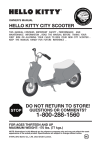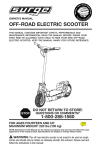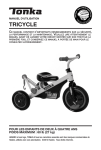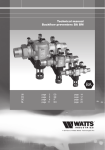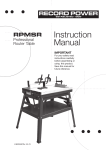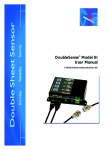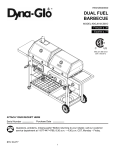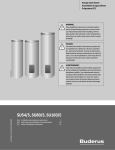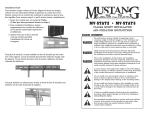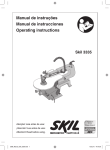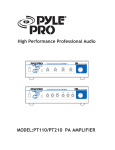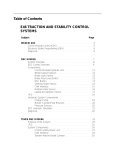Download Dynacraft ELECTRIC POWER SCOOTER Owner`s manual
Transcript
OWNER’S MANUAL ELECTRIC SCOOTER THIS MANUAL CONTAINS IMPORTANT SAFETY , PERFORMANCE AND MAINTENANCE INFORMATION . READ THE MANUAL BEFORE TAKING YOUR FIRST RIDE OR ALLOWING YOUR CHILD TO RIDE YOUR NEW ELECTRIC SCOOTER . KEEP THE MANUAL HANDY FOR FUTURE REFERENCE STOP DO NOT RETURN TO STORE! QUESTIONS OR COMMENTS? 1-800-288-1560 FOR AGES EIGHT AND UP MAXIMUM WEIGHT: 125 lbs. (56 kgs.) NOTE: Illustrations in this Manual are for reference purposes only and may not reflect the exact appearance of the actual product. Specifications are subject to change without notice. NOTE: The electric scooter must be traveling at 3 mph before the motor will engage. Kick start to 3 mph while applying the throttle to engage motor. MONSTER HIGH and associated trademarks and trade dress are owned by, and used under license from Mattel, Inc. © 2015 Mattel, Inc. All Rights Reserved. TABLE OF CONTENTS 1. Introduction, Safety and Warnings 2. Before You Begin Assembly 3. E-Scooter Parts 4. Assembly 5. Before You Ride 6. Detailed Maintenance and Repair 7. Troubleshooting Guide 8. Warranty 1 2 6 7 8 11 12 18 21 INTRODUCTION, SAFETY, AND WARNINGS ABOUT THIS MANUAL: This Manual was written to help you get the most performance, comfort, enjoyment and safety when riding your new electric scoter. It is important for you to understand your new electric scooter. By reading this manual before you or your child go out on your first ride, you will know how to get the most from your new electric scooter. It is also important that your or your child’s first ride on your new electric scooter be in a controlled environment, away from cars, obstacles, and other riders. GENERAL WARNING: Riding an electric scooter can be a dangerous activity, even under the best of circumstances. Proper maintenance of your new scooter is your responsibility and helps reduce the risk of injury. Certain conditions may cause components to fail without fault of the manufacturer. The Scooter can and is intended to move and it is therefore possible to lose control, fall off and/or get into dangerous situations that no amount of care, instruction or expertise can eliminate. If such a thing does occur, you can become seriously injured or die, even when using safety equipment and other safety precautions. RIDE AT YOUR OWN RISK AND ALWAYS USE COMMON SENSE. This manual contains many warnings and cautions concerning the consequences of failing to inspect, maintain or properly use your electric scooter. Because any fall can result in serious injury or even death, we do not repeat the warning of possible serious injury or death each time such a possibility is mentioned in this manual or the risk of falling leads to a warning. ALWAYS USE PROPER SAFETY EQUIPMENT AND RIDING ATTIRE Always use appropriate safety equipment, such as a helmet, elbow pads, knee pads, gloves, and wrist guards. A helmet is not only a good idea but may be legally required in your community. To protect yourself or your child, the helmet must meet CPSC, 16 CFR 1203, requirements and be worn correctly: 2 Always wear appropriate clothing and shoes, including long sleeved shirts and long pants and lace-up or similar shoes with rubber soles. Never ride barefoot or in sandals and make sure that shoelaces or other fasteners are tied and kept away from the wheels and drive system of the scooter. RIDER USE AND REQUIRED PARENTAL SUPERVISION RIDERS MUST NOT EXCEED THE WEIGHT LIMIT OF 125 pounds (56kg). The age grade for the scooter is for ages 8 and older. Just because someone is within the age and weight limitations specified for the scooter, does not mean that his/her size is appropriate to fit or maintain control of the scooter or that he/she is capable of safely operating the scooter. You are the best judge of whether you or your child can safely operate the scooter; this includes determining whether your child is at the appropriate developmental stage for safe use of the scooter. Any rider that is unable to fit comfortably on the scooter should never attempt to ride it. A parent’s decision to allow their child to use the scooter should be based on the child’s maturity, skill and their ability to follow rules. Keep this scooter away from small children and remember that it is intended for use only by persons who are, at a minimum, able to comfortably and safely operate the scooter. Children operating the scooter should be supervised by an adult at all times. Parents should ensure that children only use the scooter safely and within their age and physical limits. This manual contains very important safety information. It is your responsibility to completely review this information and make sure that all riders understand all of the warnings, cautions, instructions and safety topics addressed in this manual and to assure that all riders are able to safely and responsibly use the scooter. You should periodically review and reinforce all information in this manual with all riders, especially children. You should also regularly inspect and maintain your scooter to insure the safety of all riders. Make sure that your new scooter is properly fitted to any child riding it; that it is in good repair and safe operating condition; that you and your child have gone over the use, operation and safety information in this manual; that you and your child have learned and understand what to do and what not to do with your new scooter, including observing all applicable laws, rules and common sense. Children should be made aware of all possible riding hazards and correct riding behavior before they ride the scooter! Please explain the following to them as often as necessary. SAFE RIDING PRACTICES AND WARNINGS • Check and obey all local laws or regulations which may be in effect in the locations where the electric scooter may be used. • Always wear a helmet and other safety equipment and appropriate clothing and shoes. Always keep the chin strap on the helmet securely buckled. • Observe the age and weight limitations on the cover of this manual. 3 • Children must be supervised by an adult to be safe. • Always be alert and ride your scooter defensively. Watch out for obstacles that • • • • • • • • • • • • • • • • • • • • • could catch one of the scooter’s wheels or force you to turn suddenly and/or lose control. Be careful to avoid pedestrians, persons using other wheeled products (including roller or in-line skates, skateboards, scooters, bikes, etc.), children or animals who may enter your path. Always respect the rights and property of others. Do not activate the speed control/throttle on the hand grip unless you are on the scooter and in a safe, outdoor environment that is suitable for riding your electric scooter. Do not attempt or perform any stunts or tricks on the electric scooter. The scooter is not made to withstand abuse from jumping, curb grinding or any other type of misuse or stunting. Do not ride on ramps, half pipes, skateboard parks, or empty swimming pools. Keep both hands on the handlebars at all times. Do not touch the motor or brakes on the scooter when in use or directly after use as these parts can become extremely hot. Never allow more than one person to ride the scooter at one time and never try to tow anything. Do not use near steps, water, or swimming pools. Do not ride in wet or icy weather. Never immerse the scooter in water; electrical and drive components could be damaged by water or create other potentially unsafe conditions. Keep your fingers and other body parts away from the chain, motor, steering system, wheels and all other moving components. Do not ride while using a cell phone or other electronics or while wearing headphones. Never hitch on to another vehicle or let yourself be pulled or pull anyone or anything while riding the scooter. Ride only on smooth, flat, dry surfaces such as pavement or level ground without loose debris, such as sand, leaves, rocks or gravel. Water, mud, ice, bumpy, uneven, slick, or rough surfaces could impair traction and contribute to possible loss of control. Avoid excessive speeds that can occur from downhill rides which could cause loss of control. Do not ride on hills and avoid excessive speed. Avoid sharp turns, bumps, drainage grates, and other obstacles. Do not ride at night or where there is limited visibility. Do not ride indoors or on surfaces that could become damaged such as carpet or flooring. Do not ride on streets, around cars, or in foot or vehicle traffic. Regularly check the scooter and its components. If any parts are broken or worn, do not ride the scooter until you have fixed or replaced the broken or worn parts. Units shall not be operated to perform racing, stunt riding, or other maneuvers, which may cause loss of control, or may cause uncontrolled operator/rider actions or reactions. Do not to allow hands, feet, hair, body parts, clothing, or similar articles to come 4 in contact with moving parts, wheels, or drivetrain, while the engine is running. ・ Before each cycle of operation, the operator shall perform the preoperation checks specified in this manual and/or by the manufacturer, including: ・ That all guards and pads originally supplied by the manufacturer are in proper place and in serviceable condition; ・ That the area that the unit is to be operated in is safe and suitable for safe operation; ・ That the braking system is functioning properly; ・ That all safety labels are in place and understood by everyone, including the rider; ・ That any and all axle guards, chain guards, or other covers or guards supplied by the manufacturer are in place and in serviceable condition; and ・ That tires/wheels are in good condition, inflated properly (if applicable), and have sufficient tread remaining. ・ Operators/riders shall adhere to all manufacturer’s recommendations and instructions, as well as comply with all laws and ordinances, including: ・ Units without headlights shall be operated only with adequate daylight conditions of visibility, and ・ Owners/riders should highlight and make the scooter conspicuous, including the use of lighting, reflectors, and for low-riding units, signal flags on flexible poles. ・ Persons with the following conditions shall be cautioned not to operate the scooter: ・ Those with heart conditions; ・ Pregnant women; ・ Persons with head, back, or neck ailments, or prior surgeries to those areas of the body; and ・ Persons with any mental or physical conditions that may make them susceptible ・ ・ ・ to injury or impair their physical dexterity or mental capabilities to recognize, understand, and perform all of the safety instructions and to be able to assume the hazards inherent in the use of the scooter. Operators/riders always shall use appropriate protective clothing, including but not limited to a helmet, with appropriate certification, and any other equipment recommended by the manufacturer. Avoid sharp bumps, drainage grates, and sudden surface changes. Maximum Operating speed:should never exceed 10mph. PRE-RIDE SAFETY CHECKLIST ・ Check to make sure that the brake system is functioning properly. ・ Check to make sure that all components are properly secured and are functioning according to the manufacture’s specifications. ・ Components must be maintained and repaired and only with the manufacturer’s authorized replacement parts. Installation should be performed only by qualified personnel. USING THE CHARGER The charger should be examined regularly for damage to the cord, plug, enclosure 5 and other parts. In the event such damage has occurred, the scooter should not be charged until the charger has been repaired by qualified personnel or replaced. Use only the supplied, recommended charger. Always use caution when charging. The charger is not a toy and should be operated by an adult. Never operate the charger near flammable materials or liquids, and operate the charger in well-ventilated areas. Disconnect the charger and unplug it from the scooter when not in use. Do not exceed the recommended charging time. Always disconnect the charger from the scooter prior to wiping down or cleaning the scooter with any liquid. FAILURE TO HEED THE WARNINGS LISTED ABOVE INCREASES RISK OF POTENTIALLY SERIOUS INJURY. USE THE APPROPRIATE CAUTION WHEN RIDING AND ALWAYS WEAR PROTECTIVE GEAR. BEFORE YOU BEGIN ASSEMBLY Remove contents from box. Inspect the contents of the box for scratches in the paint, dents or kinked cables that may have occurred during shipping. WARNING: Make sure that the power switch is turned “OFF” before assembling or conducting any maintenance on the scooter. ESTIMATED ASSEMBLY TIME Assembly by adult with mechanical experience recommended. You should allow approximately 20-25 minutes for assembly, not including initial charging time. Initial charging can take approximately 18 hours (see page 10 for charging information) Required Tools • 4mm and 5mm Allen key (included) • 8mm and 10mm wrench (included) • 13mm and 17mm wrench (not included) • Phillips screw driver (not included) • Bicycle tire pump for Schrader valve tires with pressure gauge (not included) WARNING: DO NOT USE NON-ORIGINAL OR NON-RECOMMENDED PRODUCTS WITH YOUR ELECTRIC SCOOTER. Altering of the original components or the use of non-recommended replacement parts may or may not be compatible with the design and will void the warranty and may cause an unsafe condition resulting in serious injury or death. 6 E-SCOOTER PARTS PartDescription PartDescription 1. 2. 3. 4. 5. 6. 7. 8. 9. 10. 11. 12. 13. 14. 15. 16. 17. 18. 19. 20. 21. 22. 23. 7 Handlebar grip Single speed twist grip throttle Handlebar steerer tube Brake lever assembly Clamp Headset (upper / lower) Front fork Front wheel complete Front caliper brake ON / OFF switch Charger port Reset button Control module Battery (2 x 12V /4.5AH) Kickstand Motor (24V / 100W) Rear wheel complete Chain Chain tensioner Chain guard Deck plate with grip tape Battery box Frame ASSEMBLY Charger (included) Handlebar Steerer Tube 1. Slide the clamp onto the handlebar steerer tube as shown. Depress the push button located on the rear of the fork stem and attach the handlebar steerer tube onto the fork stem. The push button should align with the locator hole on the handlebar steerer tube and lock the steerer tube securely in place. NOTE: The push button should pop out through the locator hole. 2. Tighten the clamp bolts with the 5mm Allen key and 10 mm wrench. Tighten bolts evenly and securely. NOTE: Do not completely tighten each bolt, one at a time. Rather, please alternate tightening each bolt until they are all completely tightened to assure that they are evenly tightened. NOTE: The open end of the clamp should be located in the same directin as the slot on the 8 handlebar steerer tube before you tighten it. 3. Attach handlebar (a) vertically and horizontally onto handlebar steerer tube clamp (b), install handlebar clamp and hardware (c&d) and tighten evenly and securely with the 4mm Allen key and 8mm wrench. Note: Make sure that the cable wires are smooth and out of the way before attaching to the handlebar. Note: The threaded area on the handlebar must be covered by the handlebar clamp(b). Note: Do not completely tighten each bolt, one at a time. Rather, please alternate tightening each bolt following the sequence shown in the diagram until they are all completely tightened, to assure that they are evenly tightened. 4. Attach figure-8-shaped plastic clips onto the handlebar steerer tube as shown. Inflating the Tire The front tire is inflated during production, but it invariably may lose some pressure between the point of manufacturing and your purchase. Using a bicycle style tire pump for a Schraeder valve, inflate the front tire to the PSI indicated on the sidewall of the tire. CAUTION: Use of pressurized air supplies such as those found at service stations is not recommended and if not used properly, may cause a tire to blow out. If you do use a service station pump, make sure the pressure gauge is working and then use very short bursts of air to inflate the tire to the correct PSI, taking care to avoid sudden over inflation. If you exceed the recommended PSI, release the excess pressure immediately. 9 Charging the Battery Your electric scooter may not have a fully charged battery. Therefore it is a good idea to charge the battery prior to use. Initial charge time: 18 hours, and never charge the battery longer than 30 hours. Recharge time: up to 12 hours, and never charge the battery longer than 30 hours. When the scooter is not in regular use, recharge the battery at least once a month until normal use is resumed. Run time: Up to 45 minutes of continuous ride time Average battery life: 250 charge/discharge cycles 1. Turn power OFF before charging. Plug the charger into the charger port on the electric scooter. Note: Be sure to properly align the groove on the charger input plug with the corresponding socket on the case; otherwise, no charging action will occur. CHARGER CHARGER PORT 2. Plug the charger into a wall power outlet. The light on the charger housing should illuminate. A red LED light indicates the battery is charging and a green LED indicates the battery is fully charged. (If the lights on the charger do not light up, check the power to the outlets. If necessary, try a different electrical outlet.) WARNING: Always disconnect your scooter from the charger before cleaning with liquid. WARNINGS: ・ Turn off power switch when not in use. ・ Batteries may become damaged and could no longer accept a charge, if switch is ・ left in the ON position when not in use. Fully charge the battery before storage. WARNING: Failure to recharge the battery at least once a month may result in a battery that will no longer accept a charge. Note: If your charger does not look like the one illustrated, your unit has been supplied with an alternative charger. The specifications and charging procedure would not change. The charger has a small window with one LED or two LEDs to indicate the 10 charge status. Refer to the illustration on the charger unit for the actual “charging” and “charged” status indications for your model charger. Chargers have built-in overcharge protection to prevent battery from being over-charged. Charger will get warm during use. This is normal for some chargers and is no cause for concern. If your charger does not get warm during use, it does not mean that it is not working properly. WARNING:Charging produces explosive gases. Charge battery in a well ventilated area, away from sparks, flames, smoking and combustibles. BEFORE YOU RIDE Before you ride always check for the following: Safety Gear Always wear proper protective gear such as: • Approved safety helmet. (Helmet may be legally required by local law or regulation in your area.) • Elbow pads, knees pads and wrist guards • Long sleeved shirt, long pants • Gloves • Lace up shoes with rubber soles. Brake Check the brakes for proper function. When lever is squeezed it should slow/stop the rear wheel without excessive effort. When you apply the brake with the throttle on, the brake cut off switch should stop the motor. Make sure that the brakes are not rubbing when the lever is not being squeezed. Do not ride the scooter if the brakes are not functioning properly. Throttle Once the power switch is placed in the “ON” position, kick the scooter up to 3mph (5kmh) and then twist the throttle to engage the motor; the scooter will move. Make sure that before the throttle is twisted you are in an open and safe area to ride, you are balanced on the scooter and have both hands on the handlebar controls. Tires Inspect the wheels/tires for excess wear and replace if necessary. Regularly check the front tire pressure and re-inflate as necessary. Frame, Fork and Components Always carefully inspect your scooter before you ride. Check for cracks, broken, worn or loose components which should be repaired or replaced before your ride. 11 Battery Always make sure the power switch is in the “off” position whenever the scooter is not in use. Never store the product in outdoor conditions, never store it in the rain, and never store the product in freezing or below freezing temperatures. These low temperatures will permanently damage the battery. WARNING: Always ensure that you are in a safe open area to ride before you engage the throttle. Never twist the throttle without being on the scooter in a balanced, ready to ride position with both hands on the handlebar controls. Failure to follow these instructions may damage your scooter and void your warranty. WARNING: A Scooter that does not work properly can cause you to lose control and fall. Inspect the entire scooter thoroughly before every ride, and do not ride the scooter until any problem has been corrected. DETAILED MAINTENANCE AND REPAIR Turn power switch “OFF” before conducting any maintenance procedures. Adjusting the Brakes Tools required: 10mm wrench 1. To adjust the brake cable tension, turn the adjusting barrel on the brake lever clockwise (to loosen) or counter-clockwise (to tighten). Only turn the adjusting barrel in small increments until the desired adjustment is reached. If the brake continues to need adjustment, proceed to the next step. NOTE: Keep brakes properly adjusted and in good working condition at all times. Check to make sure that brakes are functioning properly after any adjustment and before riding. 2. If brake is too tight or has too much slack, use a 10mm open wrench to loosen the brake cable and adjust accordingly. Ensure that the the 10mm nut is secruely tightened after the adjustment is made. 12 WARNING: The brake could be capable of locking up and causing the rider to loose control and fall or be thrown from the scooter if not applied correctly. Practice using the brake in an unobstructed, open area to become familiar with its function and until you can make smooth, controlled stops. 3. Inspect the brake pads (A) for proper alignment against the wheel and for excess wear. To realign brake pads, loosen the fixing nut (B) and adjust the pad to contact the rim. Retighten and test. Readjust as needed. Front wheel Replacement Tools required: 10mm wrench, two (2) 17mm wrenches (not included) and a flat head screwdriver (not included). 1. Using a 10mm open wrench, loosen the brake cable bolt. 2. Using two 17mm wrenches, loosen the front axle locknuts by turning the wrenches counter clockwise. Remove wheel and install replacement wheel according to the diagram, making sure that front axle locknuts are securely tightened. NOTE: Hardware sequence Left Side (Brake) A - 17mm locknut B - Washer C - (Long) spacer D - Front wheel axle 13 Right Side (Throttle) A -17mm locknut B - Washer C - (Long) spacer Chain, Chain Tensioner and Rear Wheel Replacement Tools required: Phillips screwdriver, 10mm wrench, two (2) 8mm wrenches, and two (2) 13mm wrenches. 1. With a Phillips screwdriver, loosen the two screws and remove the chain guard. 2. With two 13mm wrenches, loosen the axle locknuts. 3. Then draw the rear axle out. 4. Remove rear wheel. NOTE: Rear wheel hardware sequence: Left Side (Brake) A - M8Nut B - Washer C - (Long) spacer sleeve Right Side (Throttle) A - M8Nut B - Washer C - (Short) spacer sleeve D - Rear Wheel Axle 14 5. Install new chain or rear wheel. First, slide the rear axle into the rear wheel (make sure that all hardware follows the sequence in the illustration). 6. Lift the chain tensioner (make sure the spring on the chain tensioner arm is functioning well against the chain) 7. Then maneuver the chain onto the small sprocket of the motor at front, and the big sprocket on the rear wheel. NOTE: the chain tensioner must function well against the chain to ensure the chain will not come loose during usage. 8. Slide the axle (with the rear wheel set) into the slots on the frame as shown above (make sure that the axle has slid to the end of the slots before tightening), then tighten the axle with the locknuts on both sides, making sure that they are securely and evenly tightened. 15 9. Tighten the three screws on the chain guard with a Phillips screwdriver. Chain Tensioner Replacement: NOTE: Use a Philips screwdriver to remove the 2 bolts from the rear chain cover 1. Lift the chain tensioner arm up. 2. Use the Phillips screwdriver to loosen (counter-clockwise) the bolt on the chain tensioner. 3. Pull out the worn chain tensioner and replace it with a new one. 4. Repeat the steps above in reverse to secruely tighten all bolts before finishing. Battery Care and Disposal Do not store the battery in temperatures above 75°F (23.5°C) or below 32°F (0°C). THIS SCOOTER CONTAINS SEALED LEAD ACID BATTERIES WHICH MUST BE RECYCLED IN ACCORDANCE TO YOUR LOCAL AND STATE LAWS. PLEASE CAREFULLY READ AND UNDERSTAND THE FOLLOWING DISPOSAL INSTRUCTIONS: Disposal: This product contains sealed lead acid batteries which must be disposed or recycled in an environmentally safe manner. Do not dispose of the batteries in your household trash. Do not dispose of the batteries in a fire, as the batteries may explode or leak. The incineration, disposal in landfill and/or placing sealed lead acid batteries with household trash is prohibited by law in most areas. Return exhausted batteries to a state or federal approved lead acid battery recycler or check with your local retailer of vehicle batteries. If you live in Florida or Minnesota, it is prohibited by law to throw away lead-acid batteries in the municipal waste stream. 16 Charger The charger supplied with the scooter should be regularly examined for damage to the cord, plug, enclosure and other parts. And in the event of such damage, the scooter must not be charged until the charger has been repaired or replaced. Only use the supplied battery charger or recommended replacement charger. WARNING: Always disconnect your scooter from the charger before cleaning with any liquid. Wheels Wheels and drive system components are subject to normal wear and tear. It is the responsibility of the user to regularly inspect wheels for excess wear and adjust and replace drive train components as required. Replacement Parts Most of the common replacement parts are available for purchase on line at www.dynacraftbike.com Customer Service and Repair Help • Check online at www.dynacraftbike.com • Call to speak with a customer service representative 1.800.288.1560 7AM TO 4PM pacific time. WARNING: 1. Do not mix old and new batteries. Do not mix alkaline, standard (carbon-zinc), or rechargeable (nickel-cadmium) batteries. 2. Do not store the battery in temperatures above 75°F (23.5°C) or below 32°F (0°C). 3. If a battery leak develops, avoid contact with the leaking acid and put the battery in a plastic bag. Refer to disposal information above. If acid comes into contact with skin or eyes, flush with cool water for at least 15 minutes and contact a physician. 17 TROUBLESHOOTING GUIDE Problem Possible Cause Solution Scooter will not run Charger is not working Make sure power flow to the wall outlet is on. Scooter must be traveling 3mph before motor will engage Kick start to 3mph while twisting the throttle to engage motor. Battery needs a charge Charge the battery. A new battery should be charged for at least 18 hours before using the scooter for the first time and up to 12 hours after each subsequent use. Wires or connectors are loose or unplugged Check to ensure that charger is tightly plugged into both the wall outlet and the scooter. Scooter suddenly Circuit breaker has stops working while tripped in use Check all wires and connectors to make sure they are connected and tight. The reset button (on the left side of the battery box) will automatically trip and turn off the power if the motor is overloaded. An excessive overload, steep incline or too heavy of a rider could have caused the motor to overheat and tripped the breaker. If this occurs and the scooter suddenly stops running, wait a few seconds and then push the reset button in to reset the circuit. Correct the condition that caused the breaker to trip to avoid repeatedly tripping the breaker. 18 Problem Possible Cause Scooter run time is Battery requires short (less than 15 charging minutes per charge) Solution Fully charge the battery. First charge should be 18 hours and up to 12 hours for recharges. Check to ensure that charger is tightly plugged into both the wall outlet and the scooter. Make sure power flow to the wall outlet is on. Battery is old and will not Battery may need to be replaced. accept full charge Even with proper care, rechargeable batteries do not last forever. The average rechargeable battery life is 1 to 2 years depending on scooter conditions and use. Replace only with Dynacraft recommended replacement batteries. Brakes are not adjusted Refer to the instructions on adjusting correctly (brake too tight ) the brakes on page 13. Scooter runs sluggishly 19 Brakes are not adjusted Refer to the instructions on adjusting correctly (brake too tight ) the brakes on page 13. Scooter is overloaded Make sure you do not overload the scooter by allowing more than one rider at a time, exceeding the 125 Ibs. (56kgs.) maximum weight limit, going up steep inclines or towing objects behind the scooter. If the scooter is over loaded, the circuit breaker may trip and shut off power to the motor. Correct the riding condition that caused the over load, wait a few seconds, and then push the reset button to reset the circuit. Avoid overloading the scooter as this will prematurely wear out the batteries and components. Unsuitable riding conditions Ride only on solid, flat, clean and dry surfaces such as pavement or level ground. Problem Possible Cause Solution Sometimes the Loose wires or connector scooter doesn’t run, but other times it does Motor or electrical switch damage Check all wires around the motors and all connectors to Make sure they are tight. Scooter makes loud Chain is too dry noises or grinding sounds Apply a lubricant such as 3 in 1™ or Tri-Flow™ to the chain. Charger unable to plug into the scooter charging port Check to see if there is any dust or debris. If there is, gently draw the debris out with a small stick. (Do not use needles or any other metal objects to remove debris, as this could lead to a short circuit.) Contact Dynacraft Customer Service at 1-800-288-1560 20 WARRANTY Limited Warranty Subject to the following limitations, all electric scooters manufactured for Dynacraft are warranted to the original purchaser to be free of defects in materials and workmanship for a period of 90 days from the date of purchase. No other express or implied warranty is given. Dynacraft will replace without charge those component parts that are determined by Dynacraft to be defective in materials or manufacture under normal use and service during the warranty period. The original purchaser will be responsible for any and all labor charges connected with the repair or replacement of component parts. This Limited Warranty does not apply to normal wear and tear, such as to wheels/tires, cables, or other components that wear with use, nor to claimed defects, malfunctions, or failures that result from abuse, neglect, improper assembly, improper maintenance, lack of maintenance, improper storage, alteration, modification, collision, crash, or misuse of the Dynacraft electric scooter. Dynacraft does not encourage stunting, trick riding, ramp riding, jumping, aggressive riding, riding on severe terrain, riding in severe climates, riding with heavy loads, commercial activities, or other similar activities; such use is inherently dangerous, can cause serious injury to the rider, and if done, it is with the rider and/or the rider’s parent’s express and implied assumption of the risk of such use, and Dynacraft shall not have any responsibility for any resulting break down of the scooter or its components, or for any rider injuries that occur during such use. Riding an electric scooter can be inherently dangerous such that bodily injury or even death can occur, especially if the rider and/or the rider’s parent does not perform the safety and maintenance checks recommended in this manual, if the rider does not wear a helmet, if the rider does not follow all applicable laws and rules, if the rider goes into traffic, rides double, or engages in aggressive, stunt or extreme terrain riding. Parents that allow their children to ride taking such actions will assume their own risk and the risk of injury to their children, and Dynacraft will not be responsible. THE PURCHASE OF THIS ELECTRIC SCOOTER WILL CONFIRM THE BUYER’S AGREEMENT THAT DYNACRAFT’S LIABILITY UNDER THIS WARRANTY SHALL BE NO GREATER THAN THE AMOUNT OF THE ORIGINAL PURCHASE PRICE AND IN NO EVENT SHALL DYNACRAFT BE LIABLE FOR INCIDENTAL OR CONSEQUENTIAL DAMAGES. This Limited Warranty will be void if the product is ever • used in a manner other than for recreation or transportation • modified in anyway • used as a rental Dynacraft does not offer an extended warranty; if you have purchased an extended warranty, it must be honored by the store from which you purchased the scooter or the appropriate party. For your records, keep your original sales receipt with this manual. 21 SB 1918/Cal. Veh. Code, §§ 406, 407.5 (CALIFORNIA) DISCLOSURE YOUR INSURANCE POLICIES MAY NOT PROVIDE COVERAGE FOR ACCIDENTS INVOLVING THE USE OF THIS SCOOTER/ ELECTRIC VEHICLE. TO DETERMINE IF ANY COVERAGE IS PROVIDED, YOU SHOULD CONTACT YOUR INSURANCE COMPANY OR INSURANCE AGENT 22 Cal. Veh. Code, § 407.5 (CALIFORNIA) DISCLOSURE (IF APPLICABLE) YOU MAY NOT MODIFY OR ALTER THE EXHAUST SYSTEM OF THIS SCOOTER TO CAUSE IT TO AMPLIFY OR CREATE EXCESSIVE NOISE PER VEHICLE CODE SECTION 21226, OR TO FAIL TO MEET APPLICABLE EMISSION REQUIREMENTS PER VEHICLE CODE 27156. 23 Dynacraft Customer Service 1.800.288-1560 7AM TO 4PM PACIFIC TIME Please have the following information available when you call: Model Number: (sample: 8595-95) Production Date: (sample: 2003.10.10) Serial Number: (sample: 03TD5899988) Having this information is required and helps us handle your call more effectively. STOP DO NOT return this item to the store. Please call Dynacraft for assistance. Dynacraft BSC, Inc. 89 S. Kelly Rd., American Canyon, CA 94503 Call Toll Free 1.800.288-1560 Monday - Friday 7AM TO 4PM PACIFIC TIME www.dynacraftbike.com 2015 Printed in China BM040 24

























